Thursday 29 April 2010
Stacy asked on the forum for some clarification about the “Nine Mothers,” and I realized I still haven’t written a Verso post about this subject. It seems like a good time to gather all the information we know so far, since I know that some of you have been catching on to a few things. ![]()
The Number Nine
First, it’s probably worth mentioning that the number Nine recurs for more than just the Nine Mothers.
The Animals
Vash learned about “the nine animals who are not bound by law” as part of his magical/religious education from Nimea. In “Vash asks one question,” the Dark Lady asks him to recite them.
“Tell me what you have learned: What are the creatures not bound by law?”
These were lessons Nimea had taught him. To be drilled on such subjects reminded him of his betrayal, and he hesitated.
“Of the creatures not bound by law there are nine,” he blurted. “Of the creatures that walk, there are the wolf, the bear, and the cat. Of the creatures that fly, there are the owl, the raven, and the bat. Of the creatures that creep, there are the serpent, the spider, and the rat.”
It would appear that Myrddin is teaching Drage about these creatures as well, since he asked Ethelmund to make the missing creatures for Drage’s toy ark in “Myrddin offers aid and advice.”
In “Cian tells his first bedtime tale,” Dantalion told how these creatures were created on earth by the Beast:
“On the sixth day he made the nine animals I have already told you.”
“Cats and wolves and bats and so forth?” she asked.
“Aye, love. He created them on the sixth day, and gave them minds to think and do, so that they would keep him company.”
The “minds to think and do” is an important detail. He said something much like it when he told how he and the other angels were created:
“And because God was not only our creator but also our Father,” he murmured, “we had our part of godliness in us, and we could think and do for our own selves, unlike the cherubim and seraphim who can only praise Him forever.”
So far, the only animals we have seen communicating with members of a different species are cats, dogs and wolves, and spiders. We have also seen hints of Vash using an owl for surveillance and message-carrying purposes.
The Dark Lady also told Vash that it was a serpent who was responsible for changing history once in the past:
“Do you know of the land Keme that is called Egypt?”
Vash hesitated again, confused by this questioning. “I have read about this land in the book that is called the Bible.”
“If you have read the Bible, you know the end of the tale. Here is the beginning: two and one half thousand years ago, a foreign prince made a journey into Egypt to marry the widowed queen and become the king, which is called Pharaoh. This was supposed to be, but it did not come to pass, for at the border a serpent bit his heel, and he died. Without this, the Hebrew people would never have left Egypt. Without this, the man Yeshua who is called Jesus would not have been born. Do you see what these creatures can do? Those ripples will reach every corner of the world.”
We might also consider that the serpent was responsible for the original history-changing moment of casting humanity out of the Garden of Eden.
And, of course, it was a raven who got this story started:
“And here is the beginning of another tale, but I cannot tell you the end. Eighteen years ago, a raven plucked an arrow from the heart of a man who lay dead on a field of battle, and she set that heart to beating again. The ripples have not yet spread far, but I can tell you this much: four years ago the man Alred who is called Duke was supposed to fall from his horse while hunting and die. Then the man Egelric was supposed to take his daughter Iylaina and go to live in the country of his grandfathers. Because that would have killed one or both of you eventually, you would have gone to the man Sigefrith who is called King, and you would have had the elf Iylaina brought home again, and you would have taken her to you. However, on the day that the man Alred was to die, he was not here in the forest hunting, but on a ship.”
Raegiming itself – a word that means “a flapping of wings” – is named for the “raven army” that moved into one of the towers when Leofric built his castle.
Generally speaking, when reading this story, it’s wise to pay attention whenever one of the nine animals shows up in a chapter.
The Bad Guys
Some of the more sinister characters in this story have numbers surrounding them, too.
In Lar’s “book of summoning demons” from “Lar wants to learn”
Here the drawings were far simpler, starting with nine pages of nine-pointed symbols, eight pages of eight-points, and so on, ending with two pages containing only a straight line and a half circle respectively, and a single last page that was ominously blank in the center, with text written entirely in red.
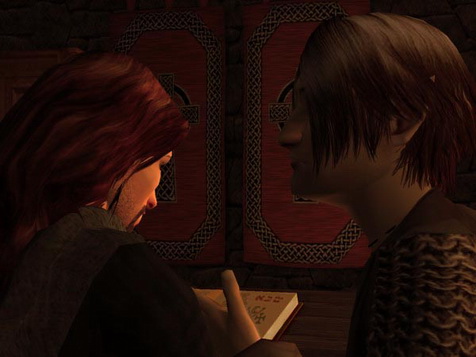
One of the eight-pointed symbols corresponds to the mark on the face of Dantalion, who is also known as temanyeh, or “Eight.” The word dré in elven means both “spider” and “eight.”
In the picture above they are looking at one of the pages of Seven, shaba, as you can tell if you squint and can read Hebrew. ![]()
In “Araphel adds an ally” we got another hint from Neshrael that their number is nine:
Not even Shemyaza was mighty enough to dare lift Dantalion off the floor and fling him across a room. Not even Azaziel was fool enough to try. None but Nine could stand up against Eight. Nine – or One, Neshrael thought. From behind, the broad-shouldered, high-headed shadow was monumental enough that Neshrael could believe it was even he.
Incidentally, in “Hanaq-Shaba smells the truth,” Dante commanded Hanaq-Shaba to send nine demons to guard over Man-Flann’s grave by night and by day.
Other Nines
Cats with their nine lives? Flann of the Nine Kirtles? Significant maybe? I don’t know. ![]()
The Nine Mothers
First of all, how do we know there are nine? I believe the only clear evidence of that we have is in “Vash receives an unintended lesson” when Vash is confronting Nimea about her lies:
“But is there another race of elf?”
“Is there another mother to them? There are only I and my sister.”
“I don’t know, Nimea. Is there another mother?”
“I just answered that question.”
“Dre told me there are nine of you.”
The Bright Lady sat up slowly, scowling. “I have told you that his lies are not worth repeating.”
“And your truths are not worth more!”
The Origin of the Mothers
We’re going to have to take the angels at their word for a lot of the following discussion. But Dante prides himself on the fact that he has never lied to Eithne; and in the conversation between Baraqiel and Araphel, they’re discussing a subject they are already familiar with, and they have no apparent reason to tell nonsense to each other in that situation.
Just bear in mind that the angels themselves may not know the full story behind everything.
From “Cian tells his first bedtime tale”:
“[The Holy Spirit] was envious, because God the Father had created time, and all the angels that were then, and perhaps her own self as well, for she wasn’t remembering a time when God was not.… Thus she too wanted to create something all alone. So she went away alone and tried… but all she could do was split off parts of her own self: her dark self, and her bright self, and she named them Night and Day.”
“Oh!” Eithne breathed. “Is that how the day and the night were made?”
“Not the night and day you know, Eithne. Now listen. She had not created something new, but she could not hide that she had tried, for Day was very bright. And God saw what she had done and was wroth. But Day and Night were beautiful, too, and He loved them, and that is how we were made. The angels of the night, such as I, and the angels of the day – Araphel and Amarel and their brothers.”
…
“But the Holy Spirit soon went away again to sin against Him by trying to create alone. Still she only shed off parts of herself – Heaven and Earth and so forth, but not the ones you know. Each was less godlike and less beautiful than the last, but they were still herself and nothing new. And they were not as bright as Day, so God did not see.”
…
“At last,” he said, “she thought to try to create something like God the Father, so that it would not be a shade of herself. And at last she succeeded in creating something new. But it was an abomination, Eithne,” he whispered, as if the very words were blasphemy. “An unholy Beast. Everything that was like God, this Beast was the opposite. If God is like a man with a face like the face of a lion, so was this Beast a lion with the face of a man.”
Some of you may recognize some hints of Gnostic theology in that story. I’m not kidding, by the way… I have had several readers express an interest in Gnosticism and Christian Apocrypha. 
Based on Wikipedia, here are some of the main features of gnosticism that are expressed in this story:
-
The notion of a remote, supreme monadic divinity.
“Monadic” means there is only One. However, in Dante’s story, the “remote, supreme divinity” instead corresponds to the Trinity consisting of God the Father, God the Son, and the Holy Ghost.
-
The introduction by emanation of further divine beings, which are nevertheless identifiable as aspects of the God from which they proceeded; the progressive emanations are often conceived metaphorically as a gradual and progressive distancing from the ultimate source, which brings about an instability in the fabric of the divine nature.
-
The introduction of a distinct creator God or demiurge… as a later emanation… this second God is a lesser and inferior or false God.
In Dante’s story, the demiurge is the Beast: “a lion with the face of a man.” The demiurge is often portrayed with attributes of a lion, but it is usually as a lion-faced creature, often with a serpent’s body. For various reasons of my own, Dante’s God Almighty is the one who has the lion-like face, and his Beast has things backwards. But the Beast is not the subject of this post, so I will leave that subject for now.
We can now recognize the Nine Mothers as corresponding to the Emanations of the Holy Spirit, each generation being less perfect than the last. Baraqiel and Araphel even refer to them thusly in “Araphel is warned”:
Baraqiel lifted his head and sighed as if he had been reminded of something else. “I have seen [Flann’s] sister as well. And lying next to her sister there was an elf.” His voice was beginning to take on a scolding tone. “This elf is entirely a creature of the Second Emanation, just as this Flann is.”
The elf he is speaking of is Paul. That makes Paul and the khírrón, and Flann and the Sidhe, both creatures of the Second Emanation.
The First Emanation must consist of Day and Night, according to Dante’s story.
If we extrapolate from this, and assume that each time the Holy Spirit split two beings from herself, we need four Emanations plus the Holy Spirit herself to account for nine.
So what blanks can we fill in at this point?
- First Emanation
- Night and Day: Kalilletha, the mother of the Angels of the Night, and ???, the mother of the Angels of the Day.
- Second Emanation
- Heaven and Earth: ???, the mother of the khírrón, and Dana, the mother of the Sidhe
- Third Emanation
- ??? and ???
- Fourth Emanation
- ??? and ???
The Mothers of the Angels
Kalilletha
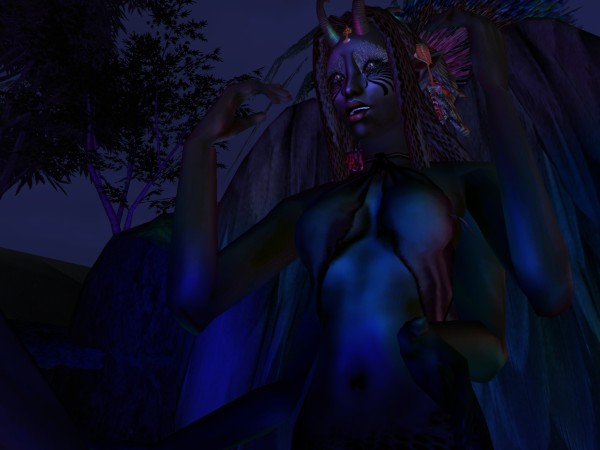
We’re quite certain who Kalilletha is, because Dante talked to her in “Dantalion gets some motherly advice.” She is Darkness and Night: a product of the First Emanation, and the highest angels are her children. She is a savage mother, however.
“Day”
We don’t know much about her, not even her name. She is the mother of Araphel’s tribe.
The Mothers of the Elves
The Bright Lady: Nimea
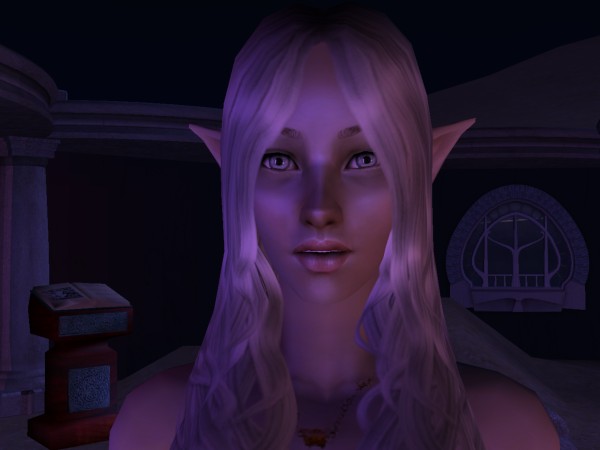
Nimea is the Bright Lady, and the kisór believe that she is the moon in the sky, and that she is their mother.
The khírrón also believe that the Bright Lady is their mother, and for what it’s worth, Nimea herself tells them so.
If you recall a certain picture from “Nimea fills in the hole” you may already know that Nimea is where Gnostic theology meets Arthurian legend in this story:
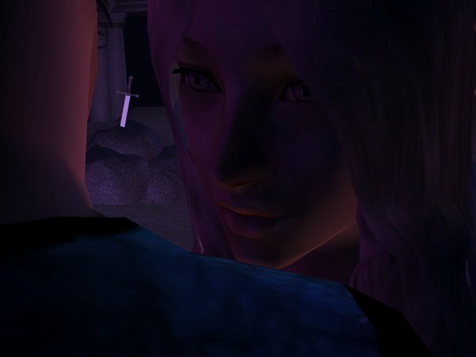
Nimea is both the Lady-of-the-Lake, guardian of the Sword in the Stone, and the sorceress Nimue, who learned all the magic she could from Merlin before locking him up.
Merlin, of course, is written Myrddin in Welsh. ![]() Now you know why Myrddin is so interested in getting to Nimea, though it’s not obvious what he intends to do with or to her once he gets there.
Now you know why Myrddin is so interested in getting to Nimea, though it’s not obvious what he intends to do with or to her once he gets there.
The Dark Lady: Morgana
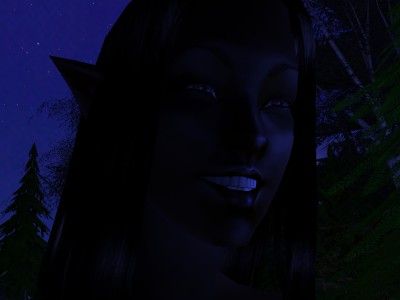
The kisór call her mór-kana – “the Lake Aunt.” They believe she is the sister of Nimea, and the mother of the khírrón.
The khírrón call her nésha, “the Dark Lady.”
Baraqiel called her Morgriana.
Everyone is a little afraid of her, but she hardly ever shows herself, and unlike Nimea does not interfere with the affairs of the elves. She did speak to Elfleda, and she threatened Egelric in “Egelric sees a dark lady,” trying to scare him into revealing who had helped him by giving him a magical flask to help him subdue Midra. She only spoke to Vash in “Vash asks one question” because she was afraid he was about to betray Nimea to Myrddin.
If we assume that Nimea is lying to the khírrón and that she is actually the mother of the kisór, that makes Morgana a being of the Second Emanation, on level with Dana.
Also, Camelot fans will note that Morgana/Morkana sounds like Morgana-le-Fay from Arthurian legend. Other than the evil-lady theme, though, it’s not evident where they have much in common.
The Other Mothers
Dana
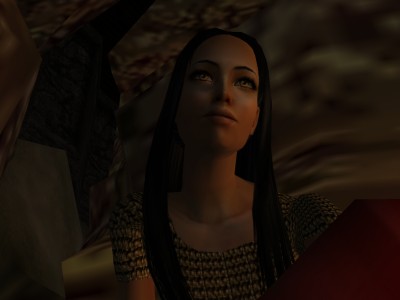
Dana is a being of the Second Emanation, and is the mother of the Sidhe: a race of magic-possessing “fairies” who occupied Ireland in ancient times. Baraqiel said of Flann:
“Never has such a child [Liadan] been born. For I have seen her mother.… She is no daughter of Eva,” Baraqiel said. “Simply put. That is how.”
Araphel’s mouth slowly fell open. He had been certain she was no demon – certain!
“Her race had its time upon the earth while we were still in chains,” Baraqiel explained. “I believe she is a daughter of Dana.”
They stared at one another in silent recognition of the impossibility of this statement.
“She is nevertheless mortal,” he added.
And Dana is meddling! She saved Eithne from Dantalion the first time he went to her. And we saw her meddling to save Paul when he almost gave his life for Cat, and we saw her meddling again to save Cat’s baby in “Benedict sees the Red Lady.” Nevertheless meddling is not allowed! She’s not a very chatty goddess, but she gets things done. ![]()
By the way, in case anyone hadn’t made the connection, the red dragon we’ve seen a few times is Dana herself. Once, when the full moon was eclipsed, she dived into Nimea’s lake. This was in “Egelric sees a dragon.”
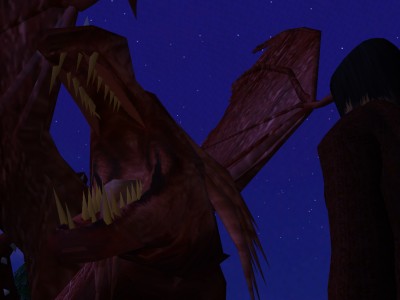
Eva
Eva is the only other Mother who has been mentioned by name. She is the mother of the men. After the Flood, God made a covenant which said (among other things… you had to read the fine print) that never more would a son of heaven have a child with a daughter of man. The last time it happened, you see, back when Araphel and his brothers had babies with human women, their children turned out to be monstrous giants, and God had to send the Flood to wipe them out. And to punish the angels, he put them in chains for a thousand years.
Araphel and Dantalion have since exploited the loophole in this contract by having babies with daughters of Dana, and leaving daughters of Eva out of it.
The Others
So far we have:
- Angels of the night (jannin)
- Kailletha
- Angels of the day
- “The Day”
- The Sidhe
- Dana
- The khírrón
- Morgana (if we so assume)
- The kisór
- Nimea
- The men
- Eva
That leaves two mothers (and two races) unaccounted for. Have fun speculating about that. ![]()














YES! I heart you with much passion.
According to the last lines, there are only 8 mothers? You listed 6 and said that 2 were unaccounted for. Am I a poor math student?
Otherwise, this post has got the gears spinning.